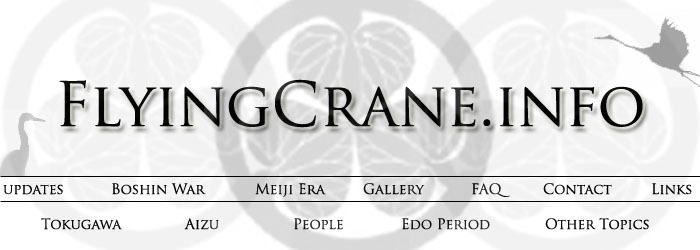

| ::PEOPLE :: This page is a work in progress. Check back soon! (NOTE: As with every page on this site, when Japanese names are given, family name is first, then "given" name.) Nagai Genba-no-Kami Naoyuki Nagai Genba-no-Kami Naoyuki presents an interesting example of an unexplored historical persona in the realm of ::Early Life::Nagai Naoyuki was born Matsudaira Iwanojo, the 2nd son of Matsudaira Mondo no Kami Noritada, daimyo of Okudono-han. (Nagai Genba-no-Kami Den [hereafter "NGKD"], p. 2) Okudono-han, rated at an income of 16,274 koku, was a small domain, with its holdings scattered throughout various districts of Mikawa and Shinano Provinces. Okudono was a domain that technically fell in the fudai category of Tokugawa-vassal domains, however, it had the distinction of being ruled by a lesser branch of the massive Matsudaira-Tokugawa clan. The Ogyu-Matsudaira, as the ruling family of Okudono were known, traced their descent from Matsudaira Kaga no Kami Norimoto, the second son of Matsudaira Chikatada, the first shogun Tokugawa Ieyasu's great-great-great-grandfather. (NGKD, p. 1) This being the case, the young Iwanojo, born by a concubine, was uncommon in the realm of daimyo's sons, in that he was not born in Edo, but instead in a residence in his father's domain. However, his status as the second son of the daimyo by a concubine precluded his appointment as the heir to the daimyo. Losing his father at age three, he was sent to Edo, where he was raised by his elder brother. (NGKD, p. 2) ::ADOPTION, EDUCATION, EARLY CAREER::The young Iwanojo was adopted at age 25 by a hatamoto (senior Tokugawa vassal), Nagai Noto no Kami Naonori. (NGKD, p. 2) Nagai Naonori had gone through a long career in the Tokugawa administration, holding several magistrate posts across the country, including Sunpu (modern-day Shizuoka), Sakai (part of modern-day Osaka), and Osaka. (Kumai p. 737) Even so, for a hatamoto to receive the son of a daimyo as his adopted heir was a great honor, and this must have pleased Naonori immensely. Iwanojo, now called Naoyuki (sometimes read Naomune or Naonobu) had received the best literary and martial training that Edo had to offer: he was a graduate of the Shogunate's elite Shoheizaka school in Edo, and excelled at his studies. Following his succession to the family headship, Naoyuki received the patronage of Abe Masahiro's patronage, and climbed the ladder of seniority in the Shogunate rather quickly, and by the early 1860s he was a metsuke (inspector), which was the entry point to the upper levels of the government's administration. (Beasley, 93ff) ::WORKS CITED::*Beasley, W.G. The Meiji Restoration. Stanford: Stanford University Press, 1972. *Doi Ryozo. Bakumatsu gonin no gaikoku bugyo: kaikoku o jitsugensaseta bushi. Tokyo: Chuokoron-sha, 1997. *Keene, Donald. Emperor of Japan: Meiji and His World, 1852-1912. New York: Columbia University Press, 2002. *Kumai Tamotsu. Edo Bakushin Jinmei Jiten. Tokyo: Shin Jinbutsu Oraisha, 1990. *"Nagai Genba-no-kami den". Kyu Bakufu 5 (DATE): 1-10. *Oishi Manabu. Shinsengumi. Tokyo: Chuo-koron Shinsha, 2004. *Totman, Conrad. The Collapse of the Tokugawa Bakufu: 1862-1868. Honolulu: University of Hawai'i Press, 1980.
|